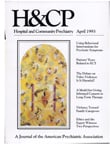Characteristics of Repeat Users of a Psychiatric Emergency Service
Abstract
Objective: Patients who visited a psychiatric emergency service were studied to determine whether repeat visitors, who consume a disproportionate share of services, could be identified by demographic and diagnostic characteristics. Methods: Data were obtained from a semistructured diagnostic interview given to all 16,257 persons who made 29,214 visits to an urban psychiatric emergency service in Pittsburgh, Pennsylvania, from 1985 to 1989. Patients were categorized into four groups based on the number of visits in the five-year period. Patients in group 1 made a single visit, while those in group 2 averaged less than one visit per year; those in group 3 made one or two visits per year, and those in group 4, more than two visits per year. Results: Groups 3 and 4 constituted 5.1 percent of the sample but made 27.1 percent of the total visits. Repeat users were significantly more likely to be male, younger, unmarried, unemployed, and nonwhite and to have diagnoses of schizophrenia, other psychotic disorders, and personality disorders. Conclusions: Repeat users of psychiatric emergency services appear to have demographic and diagnostic characteristics that may permit their early identification. For such patients, implementation of alternative management strategies, such as intensive case management, may reduce their use of services.
Access content
To read the fulltext, please use one of the options below to sign in or purchase access.- Personal login
- Institutional Login
- Sign in via OpenAthens
- Register for access
-
Please login/register if you wish to pair your device and check access availability.
Not a subscriber?
PsychiatryOnline subscription options offer access to the DSM-5 library, books, journals, CME, and patient resources. This all-in-one virtual library provides psychiatrists and mental health professionals with key resources for diagnosis, treatment, research, and professional development.
Need more help? PsychiatryOnline Customer Service may be reached by emailing [email protected] or by calling 800-368-5777 (in the U.S.) or 703-907-7322 (outside the U.S.).



